NATIONAL PARK SERVICE
Park Structures and Facilities
|

|
SIGNS and MARKERS
THE CLASSIFICATION "Signs and Markers" is not
concerned with entrance signs alone. It embraces a broad range of
devices for facilitating use, enjoyment and understanding of a park by
the public. As development of any area proceeds there is bound to be
coincident multiplication of kinds and numbers of required signs and
related objects—directional, designative, regulatory, cautionary,
or merely informative of natural or historical fact.
Nothing in parks, unless it be the entranceway,
offers wider legitimate scope for individuality in conveying the
characteristics or background of a particular area than do the signs and
markers. These can be the embodiment of those rare and distinguishing
features that have dictated the establishment of the park—the
motifs in miniature of the park motif.
A visitor on pilgrimage to the reconstructed village
of Lincoln's young manhood in New Salem State Park, Illinois, is subtly
put in receptive and reverent mood for the illusion of a mid-western
backwoods village of the eighteen-thirties by the very character of the
stylized signs and markers. The black, uncertain lettering on white
background, in its hand-made irregularity and wavering course lines, recalls
the crude typography of the newspapers and handbills of the period and
place. Instantly imagination is in pitch, and understanding in tune,
with the melody about to be re-sung for us.
The signs and markers of those parks whose glory is
some unique or unusual outcome of natural forces can often clearly echo
these characteristics to a welcome avoidance of the trite. Witness the
nature shrine at Obsidian Cliff in Yellowstone National Park, formed of
basaltic columns of hexagonal section in their natural relation to one
another, which formation is a conspicuous phenomenon of this area. There
are as well other markers herein presented, which through clever and
skillful recall of a local feature, are neither banal nor fantastic, but
succeed in achieving great individuality and distinction.
The day when the quintessence of naturalism for park
signs was to paint them on boulders and cliffs is within the memory of
many of us. Happily our developing sense of fitness has had a swing away
from this sort of thing. The utter inappropriateness of nailing signs to
trees is also better understood in the light of today's park-mindedness.
Perhaps a warning note should be sounded against a noted recent tendency
to bring to the park sign something of modern commercial eye-arresting
technique. By no means need the park entrance sign seek to compete with
the twenty-four-sheet cigarette poster further down the road nor is
there merit in three or four messages conveyed by as many different
signs, wherever all might logically be accumulated to one sign. Several
such groupings that successfully exemplify these points are illustrated
on the following pages.
There is an interesting and growing movement to
acquaint the using public with the details of a park area through the
medium of maps. The routes of foot or horse trails, the locations of
points of historical or scenic interest, the relationship between
notable features and areas of intensive or specific use are graphically
told to great advantage. Such informative devices, provided at strategic
points, can offer a wealth of fact with wide appeal to varied interests,
and make possible a broader understanding of an area than endless
tramping over the actual terrain could give.
Informative or educational maps may take the form of
simple painted signs showing the course of a particular trail, the route
to an historic spot, or the reconstruction of remains of military
earthworks or Indian mounds. They may become elaborate, decorative cartograms
or cartographs arranged under glass, visualizing geological
cross-sections, military maneuvers, subterranean caverns, or topography.
Lately the educational value of the relief model
reproducing at small scale the terrain of an entire park area has come
to be more fully appreciated. Created of plaster, such models are
already on exhibition in nature and history museums within our parks.
Proposed of concrete construction, several are now under consideration
for outdoor locations. Such models, supplemented with suitable
inscriptions, can offer comprehensive visualization of mountain-building
movements, and subsequent erosion of the land by water, wind and ice, or
convey an understanding of a military engagement or vanished
civilization that is unapproached by any other medium.
Often signs of informative or educational purpose
tend to be something very like minor museums out-of-doors. These highly
developed nature or history shrines serve to bring the recorded fact,
theory, or interpretation to the very scene of the prehistoric or
historic occurrence, or the actual location of the scientific or
natural phenomenon. This is of tremendous value in offering the most
complete exposition possible of those things which the park exists to
commemorate or to preserve. The more elaborate of these informative
devices are actually the transition between the mere sign and the museum
that has won legitimate place in a natural park. Some are at once truly
glorified sign and museum in embryo.
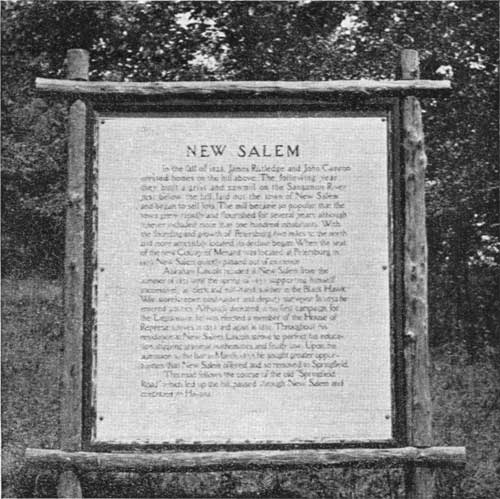
|
SIGN, NEW SALEM STATE PARK, ILLINOIS
This sign panel is illustrative of the styling of
lettering to a particular period conspicuous in the historic past of a
site or region. In this instance the era is that of the American
frontier, the motif is the primitive and faltering printing press of the
newly conquered wilderness, while the interest is the Lincoln
legend.
|
Signs in Control of Traffic
Surrounding are signs intended to function in control
of traffic. All are of pleasing, rustic character. The examples at
Custer and Dolliver Memorial State Parks serve to demonstrate clearly
the decorative quality of logs from which the knots are not entirely
obliterated. Very practical because low in height, and therefore causing
no interference with vision, are the entrance and exit signs of the
parking area at Black Hawk State Park.
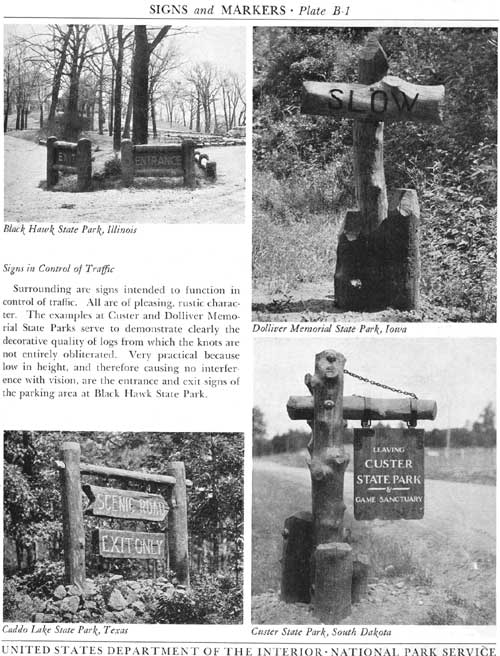
|
|
Plate B-1 (click on image for a PDF version)
|
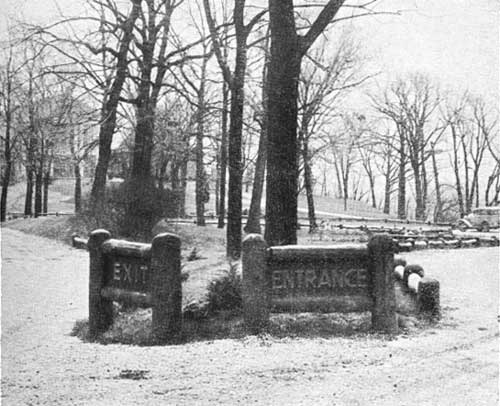
|
|
Black Hawk State Park, Illinois
|
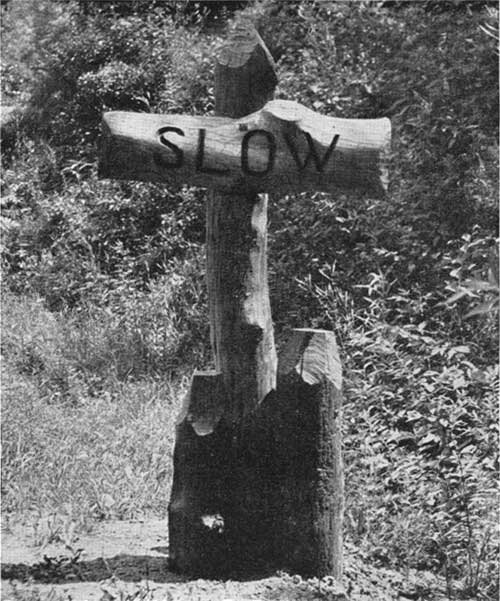
|
|
Dolliver Memorial State Park, Iowa
|

|
|
Caddo Lake State Park, Texas
|

|
|
Custer State Park, South Dakota
|
Directional Signs
Here are directional signs none the less inspired
because they are simple. Outstandingly original is the foot trail sign
post, indicating the way by means of a footprint instead of the
hackneyed pointing index finger. The failure to remove the bark from the
uprights of this sign and the companion sign directly below it, is
hardly subject to censure in the case of items so minor in character.
Signs are well kept low in height when there is no vegetation
threatening to obscure them.
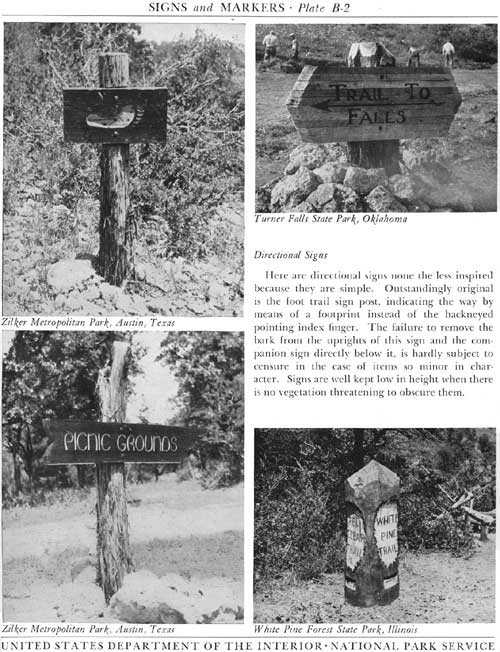
|
|
Plate B-2 (click on image for a PDF version)
|

|
|
Zilker Metropolitan Park, Austin, Texas
|

|
|
Turner Falls State Park, Oklahoma
|
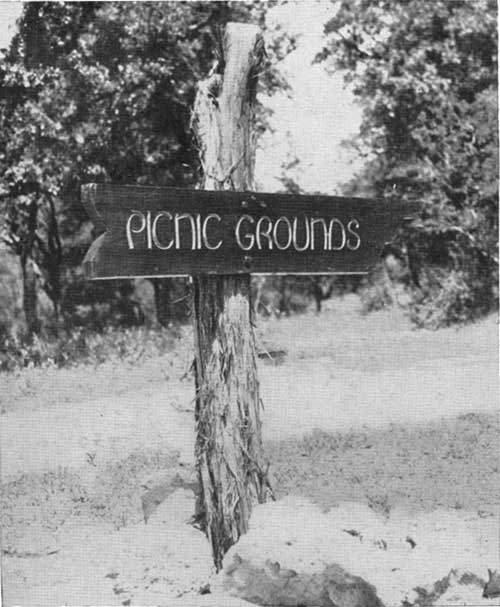
|
|
Zilker Metropolitan Park, Austin, Texas
|

|
|
White Pine Forest State Park, Illinois
|
Directional Signs
The urge to capture naivete and rusticity in park
signs should not lead to illegibility in lettering. These qualities are
best confined to the form of the sign panel itself and to the upright
supporting members. All the lettering on the signs shown in the
surrounding illustrations follows familiar forms without prejudicing
wilderness character.
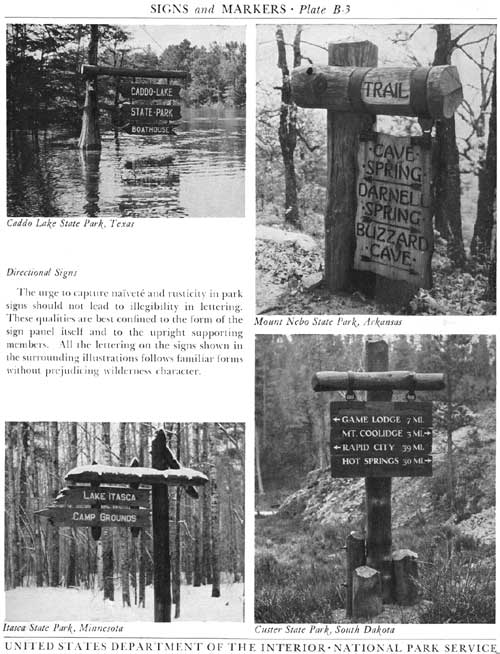
|
|
Plate B-3 (click on image for a PDF version)
|

|
|
Caddo Lake State Park, Texas
|
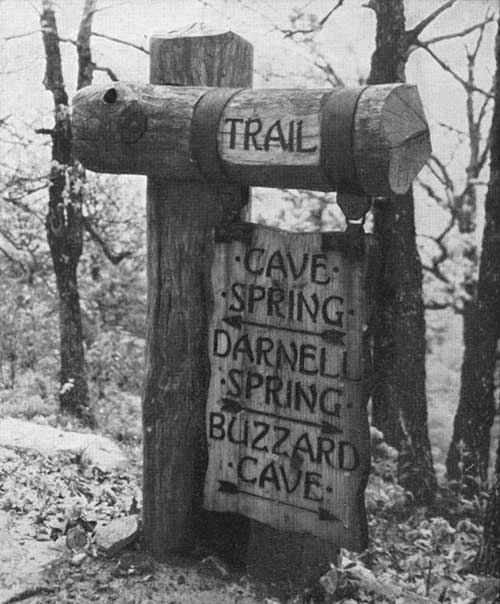
|
|
Mount Nebo State Park, Arkansas
|
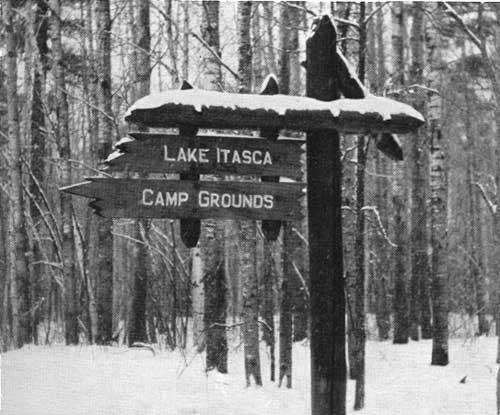
|
|
Itasca State Park, Minnesota
|
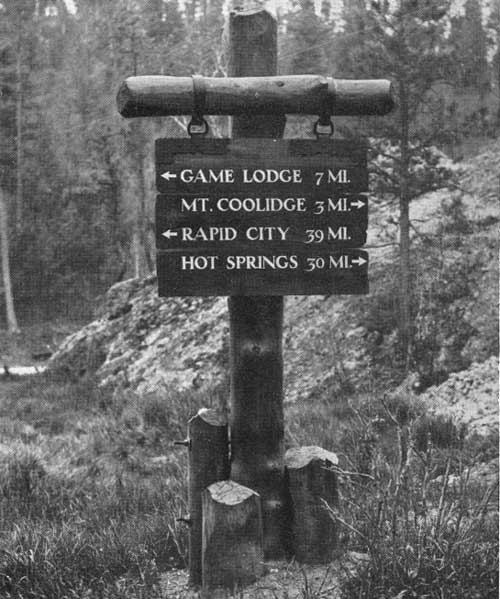
|
|
Custer State Park, South Dakota
|
Entrance or Designative Markers
In the upper examples on this page is more primitive
character than in the markers shown below. The sign at White Pine Forest
Park illustrates the possibility of combining this facility with a rail
fence. The staggering of the letters in the second line of the Kitchawan
Tavern sign will have its critics. Signs like this are produced by sheet
metal or asbestos templates, a blow torch, and, for the last line, just
the right degree of intemperance.
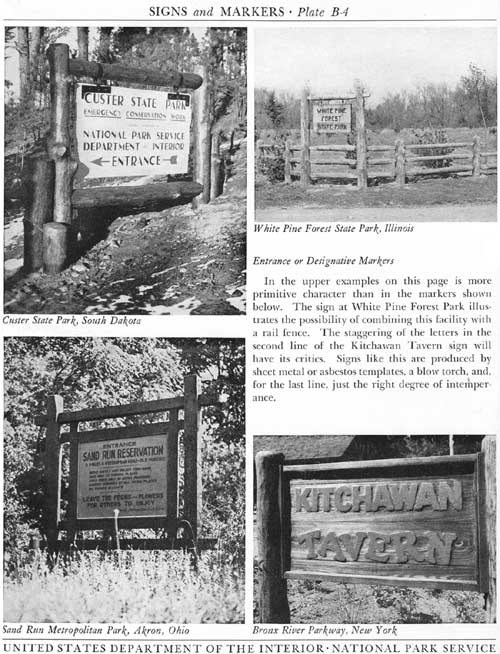
|
|
Plate B-4 (click on image for a PDF version)
|
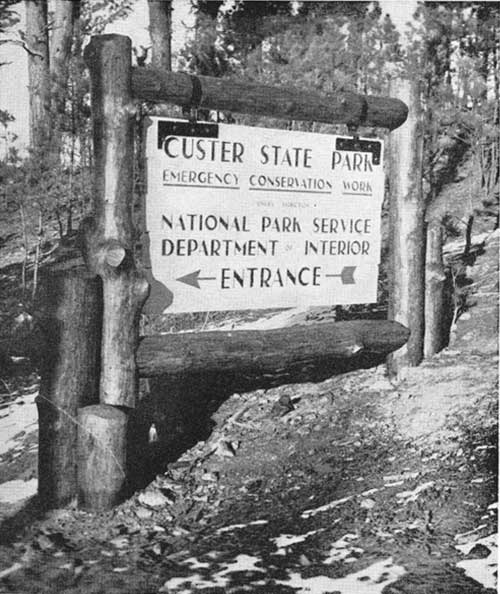
|
|
Custer State Park, South Dakota
|
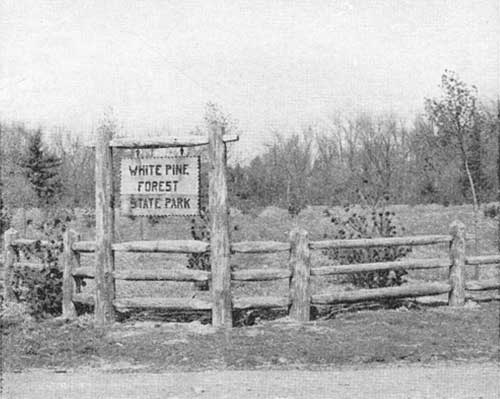
|
|
White Pine Forest State Park, Illinois
|
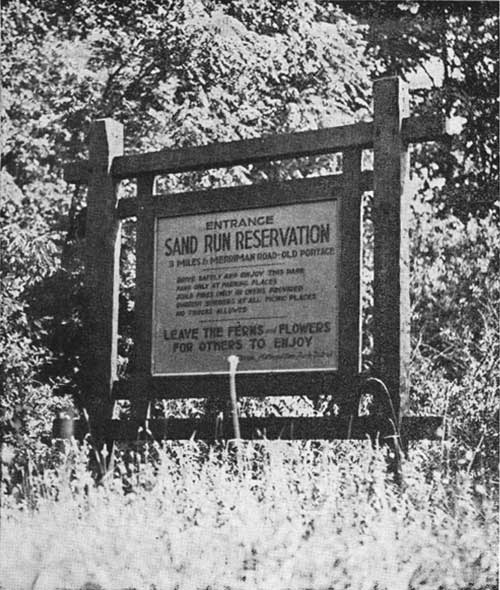
|
|
Sand Run Metropolitan Park, Akron, Ohio
|
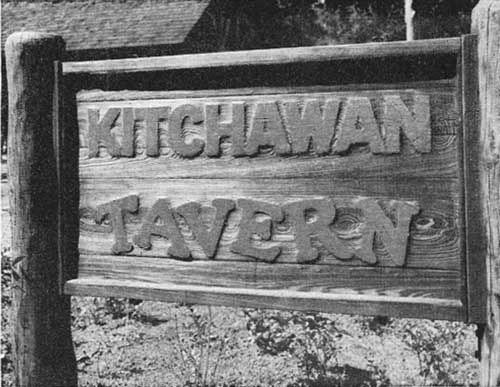
|
|
Bronx River Parkway, New York
|
Designative Markers and Nature Shrines
These items have little in common to warrant this
grouping on one page, beyond being basically signs. The Casa Grande
entrance sign is a clever conception, hammered out of sheet copper and
filled with concrete. It serves as marker and for separating in and out
traffic at the entrance to this park. The specimen at upper right
typifies the blow torch technique, with the letters painted for
increased legibility. Below are examples of the nature shrine—the
link between the mere marker and the trailside museum.
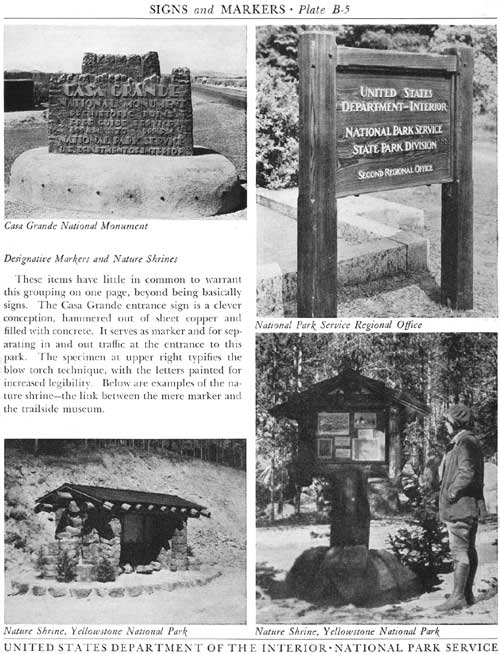
|
|
Plate B-5 (click on image for a PDF version)
|

|
|
Casa Grande National Monument
|

|
|
National Park Service Regional Office
|
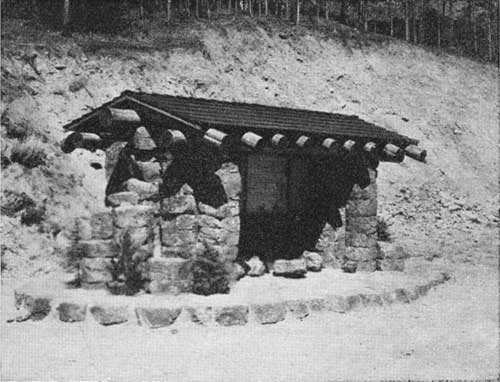
|
|
Nature Shrine, Yellowstone National Park
|

|
|
Nature Shrine, Yosemite National Park
|
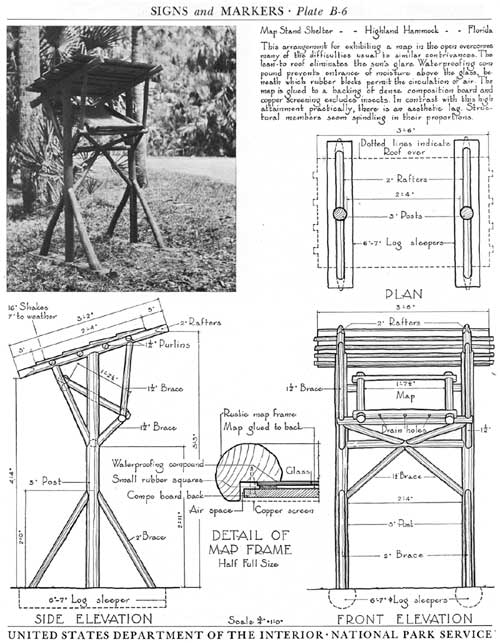
|
|
Plate B-6 (click on image for a PDF version)
|
park_structures_facilities/secb.htm
Last Updated: 5-Dec-2011
|



























